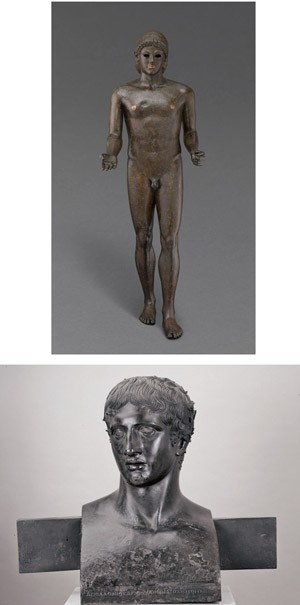A high regard for history characterizes the Hellenistic period. At the famed library founded at Alexandria in Egypt in the third century BC, scholars studied works by ancient authors reaching back to Homer. At the same time, artists fashioned statues in styles from both the distant and recent past, evoking the art of the Archaic and Classical periods. The statues of Apollo shown here adapt Archaic features to recall the stiff frontal figures of youths known as kouroi that were dedicated in Greek sanctuaries and cemeteries throughout the sixth century BC. Such works appealed to the interests of antiquarian collectors and also evoked the religious piety of a bygone age.
In contrast, the bust of the Doryphoros (Spear Bearer) faithfully replicates an original of the mid-fifth century BC by the Classical sculptor Polykleitos. Such works were popular adornments for villas and gardens, likely the original setting of most of the sculptures in this room. The process of casting bronzes in molds that were kept in workshops and reused over time may have facilitated a retrospective interest in art of the past, which inspired copies and reinterpretations made well into the Roman imperial period.
Pictured Above: Apollo ("Piombino Apollo"), c. 120 – 100 BC; bronze, copper, and silver. Lent by the Museé du Louvre, Départment des antiquités grecques, étrusques et romaine, Paris
Pictured Below: Herm Bust of the Doryphoros, 50 – 1 BC; bronze. Lent by the National Archaeological Museum, Naples
